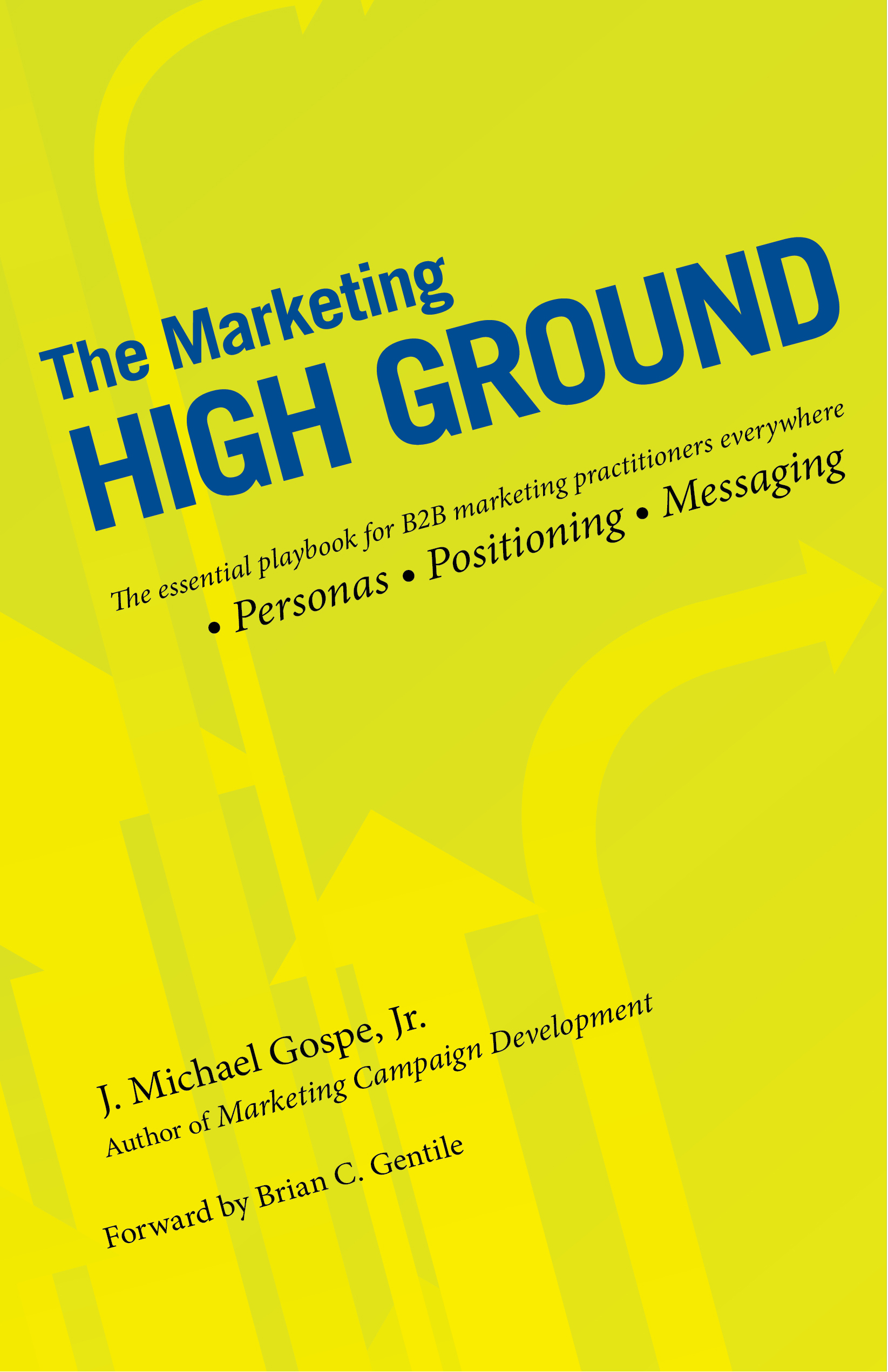Marketing High Ground Author Explores Targeting & 21st Century Marketing Tactics
- Written by Demand Gen Report Team
- Published in Industry News
 Grabbing market share requires BtoB marketers to develop and maintain a sound understanding of their target customers. Marketers are challenged to cater to customers’ priorities, worries, business challenges and needs more so than ever before.
Grabbing market share requires BtoB marketers to develop and maintain a sound understanding of their target customers. Marketers are challenged to cater to customers’ priorities, worries, business challenges and needs more so than ever before.
Mike Gospe, Co-Founder and Principal of sales and marketing leadership consulting firm KickStart Alliance, explores key topics including personae, positioning statements and messaging in his new book, The Marketing High Ground. In an exclusive interview with DemandGen Report, Gospe shared insights into how technological advancements will affect the future of marketing, and the tools that will help BtoB marketers position their organizations for success.
DemandGen Report: In The Marketing High Ground, you include a chapter on “Marketing Lessons for the 21st Century,” where you advise that successful marketing is not just about technology, but about understanding the target customer. Can you expand?
 Mike Gospe: Technological advancements will continue to offer new and innovative ways for people to communicate with each other and for marketers to streamline the business of marketing. However, if we aren’t careful, these innovations can become a distraction, causing us to take our eyes off of the customer.
Mike Gospe: Technological advancements will continue to offer new and innovative ways for people to communicate with each other and for marketers to streamline the business of marketing. However, if we aren’t careful, these innovations can become a distraction, causing us to take our eyes off of the customer.
For example, consider the early days of marketing automation where many marketers considered this technology as the silver bullet that would automatically improve their ROI. The lesson we learned here was “garbage in, garbage out.” Automating action without regard to an aligned and integrated marketing-sales strategy only led to frustration and miss-set expectations regarding the (larger) quantity and (lower) quality of leads that flowed through the pipeline. Marketing automation is not a replacement for having a clear and focused strategy. A customer-focused strategy must always come first.
Successful marketing in the 21st century will not be because of any single tool or communication vehicle. It remains about the customer, the type of information and content they are looking for, and which venues and media they prefer to use to collect, store, forward and consume this information during their buying process. The customer will define what our integrated marketing strategy should be, not the technology.
DGR: The book also explores why positioning statements are critical for success and includes case study examples of the pitfalls companies without a statement have faced as a result. What is the primary consideration for mapping out a positioning statement?
Gospe: First comes the realization that having a positioning strategy is not optional, especially in today’s fast-paced, highly competitive marketplace. Customers always have choices, and if we can’t help guide them in understanding the differences among the options and the superiority of what we offer, then we can only hope for success. And hope is a very risky strategy. This is difficult for some business leaders to understand because many technology companies have been successful selling products without a seasoned marketer seated at the corporate leadership table.
Eventually, these “engineering-driven” or “sales-driven” companies always run out of steam because those leaders were never trained to understand the nuances of complete markets – markets that may shift at any time. The most effective companies are “market driven,” meaning that they focus always on the customer first, the product second. In these companies, marketers are seen and valued, internally, as the “customers’ advocate.”
So job number one is in recognizing that having a positioning strategy is required. More so, the strategy must be documented in a simple framework that can be shared and communicated broadly throughout the company. Without a common framework and an agreement on the words to use, people in the organization will have differing understandings of the product’s value. And if management, sales, and marketing are not aligned, chaos and frustration will follow.
DGR: In the book you discuss competitive differentiation, which every organization is challenged with. Can you expand on what it means to truly differentiate products and services? How should organizations internally map out this process?
Gospe: It’s easy for marketers to become frustrated with trying to find a unique competitive differentiator. But, I’m a firm believer that there are always meaningful differences that can be found. Even if the product’s attributes are generic, there are opportunities to differentiate based on brand, reputation, geographic location, green practices, etc. In addition, when products are generic, some companies decide to differentiate at the corporate or brand level instead of the product level. Bottom line: there are always possibilities. All we need is a bit of creativity to sort out the options.
The best place to start the internal dialog about finding then articulating a true differentiator is by using the technique I call “firsts, bests, and onlys.” Gather a few sales, marketing, and product experts in a room and ask the following:
- Were we first to market? Which features or benefits can we claim to be first in providing?
- What do we do better than the competition? Which features and benefits can we claim to be the best at delivering?
- What is truly unique about our solution? What aspects of our solution can we claim to be the only provider of?
This is an important topic and the answers may not be easy to find, but answers are out there. It takes patience and honesty to navigate this discussion.

DGR: You break down “The Message Box,” a tool for marketers to tell their stories. Can you explain how this works and why “storytelling” has become a successful way to communicate the value proposition?
Gospe: Nobody likes being sold to. In fact, I’d venture to say that most people go out of their way to avoid the sales rep. This is because most companies yell at prospects with their “buy now!” messaging. This intrusive approach to marketing is all about the manufacturer and not about the customer. We need to change this. People are in control of their buying processes, meaning that they choose whom to listen to, and when. If we aren’t in tune with their buying process, we will annoy our customers and prospects will ignore us.
The message box offers an approach to remind us that we need to understand the customer prior to selling to them. The message box is a tool with a singular focus: to summarize the value proposition, using customer-friendly language that will hook the prospect so they will respond with “Tell me more.” Those three little words are magical, offering an invitation to delve in to deeper details.
In short, customers will never buy from us if they don’t know who we are and if they don’t feel we are a credible source of information, solutions, and expertise. This must be established first before we offer coupons, discounts, and the like. Rather than blurt out all our messages at once, the message box helps us create and deliver our messages in a logical sequence. This approach allows us to overlay their buying process with messages that will guide them through (or out of) our lead gen funnel quickly.
DGR: Many BtoB organizations struggle to communicate marketing plans internally. In the book you offer steps for “socializing the output.” Can you expand?
Gospe: Just because a marketer produces a plan doesn’t mean that anyone will know about it, much less understand it. This was a lesson I learned the hard way. Success requires that marketers to become internal evangelists for their plans and recommendations. Here are a few tips that made a world of difference to my ability to sell my plans (as well as my ability to earn a promotion):
1) Three key slides: Marketing plans are lengthy, detailed, and boring to non-marketers. Rather than emailing or printing out the entire deck and circulating it widely, I focused on sharing only three slides: the persona, the positioning statement, and the message box (or elevator pitch summary). Three slides are much easier for sales reps and marketing peers to understand. If they want more information, you can always provide it. But let them ask for it rather than you pushing it.
2) Go on the talk circuit: Ask to be invited to the regional sales conference calls or webinars. Get 15 minutes on the agenda to walk through these three slides. Also include a slide of the immediate marketing deliverables that will soon be available to the sales team. Sales folks only care about the program deliverables and leads. But resist the temptation to forego the persona, positioning statement, and message box slides. They need to know this, and the best way is to tell them in person.
3) Rinse and repeat: Just because you’ve communicated the plan once doesn’t mean anyone remembers what you said. Look for opportunities to repeat the information. Better yet, look for opportunities for others to repeat your slides for you. For example, work with the sales leaders so they can personalize the three slides and use them in their own account plans. Once they adopt your material as their own, you are home free.
Mike Gospe is Co-Founder of KickStart Alliance, a sales and marketing leadership consulting team. With 25 years of marketing expertise is in integrated marketing and voice-of-the-customer programs. Gospe also authored the book Marketing Campaign Development.

